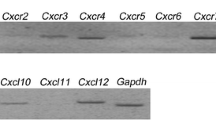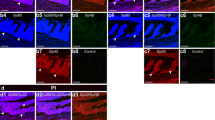Abstract
This study provided the first analysis of the distribution of a CXCL14-like chemokine in the Japanese eel (Anguilla japonica) pituitary using immunohistochemical techniques. CXCL14-immnoreactive cells were observed in the rostral part of the pars distalis (RPD) and the pars intermedia (PI). The CXCL14-immunoreactive cells were found to correspond to adrenocorticotropic hormone (ACTH)-producing cells in the RPD and α-melanocyte-stimulating hormone (αMSH)-producing cells in the PI. Therefore, the CXCL14 secreted from the αMSH-producing cells and ACTH-producing cells in the pituitary may participate in the modulation of insulin secretion, as well as energy metabolism, together with αMSH and/or ACTH via endocrine mechanisms.



Similar content being viewed by others
References
Al-Majed HT, Jones PM, Persaud SJ, Sugden D, Huang GC, Amiel S, Whitehouse BJ (2004) ACTH stimulates insulin secretion from MIN6 cells and primary mouse and human islets of Langerhans. J Endocrinol 180:155–166
Atanes P, Hawkes RG, Olaniru OE, Ruz-Maldonado I, Amisten S, Persaud SJ (2019) CXCL14 inhibits insulin secretion independently of CXCR4 or CXCR7 receptor activation or cAMP inhibition. Cell Physiol Biochem 52:879–892
Brennan MB, Costa JL, Forbes S, Reed P, Bui S, Hochgeschwender U (2003) α-Melanocyte-stimulating hormone is a peripheral, integrative regulator of glucose and fat metabolism. Ann N Y Acad Sci 944:282–287
Cao X, Zhang W, Wan T, He L, Chen T, Yuan Z, Ma S, Yu Y, Chen G (2000) Molecular cloning and characterization of a novel CXC chemokine macrophage inflammatory protein-2γ chemoattractant for human neutrophils and dendritic cells. J Immunol 165:2588–2595
da Silva JM, Soave DF, dos Santos TPM, Batista AC, Russo RC, Teixeira MM, da Silva TA (2016) Significance of chemokine and chemokine receptors in head and neck squamous cell carcinoma: a critical review. Oral Oncol 56:8–16
Grandi G, Colombo G, Chicca M (2003) Immunocytochemical studies on the pituitary gland of Anguilla anguilla L., in relation to early growth stages and diet-induced sex differentiation. Gen Comp Endocrinol 131:66–76
Hara T, Nakayama Y (2009) CXCL14 and insulin action. Vitam Horm 80:107–123
Hromas R, Broxmeyer HE, Kim C, Nakshatri H, Christopherson II K, Azam M, Hou YH (1999) Cloning of BRAK, a novel divergent CXC chemokine preferentially expressed in normal versus malignant cells. Biochem Biophys Res Commun 255:703–706
Inoue JG, Miya M (2001) Phylogeny of the basal teleosts, with special reference to the Elopomorpha. Jpn J Ichthyol 48:75–91 (in Japanese)
Kamei H, Kawazoe I, Kaneko T, Aida K (2005) Purification of follicle-stimulating hormone from immature Japanese eel, Anguilla japonica, and its biochemical properties and steroidogenic activities. Gen Comp Endocrinol 143:257–266
Kim DJ, Park CW, Kim DW, Park HK, Byambaragchaa M, Lee NS, Hong SM, Seo MY, Kang MH, Min KS (2016) Production and characterization of monoclonal antibodies against recombinant tethered follicle-stimulating hormone from Japanese eel Anguilla japonica. Gen Comp Endocrinol 233:8–15
Kurth I, Willimann K, Schaerli P, Hunziker T, Clark-Lewis I, Moser B (2001) Monocyte selectivity and tissue localization suggests a role for breast and kidney-expressed chemokine (BRAK) in macrophage development. J Exp Med 194:855–861
Lowry P (2016) 60 Years of POMC: purification and biological characterization of melanotrophins and corticotrophins. J Mol Endocrinol 56:T1–T12
Marchelidon J, Schmitz M, Houdebine LM, Vidal B, Belle NL, Dufour S (1996) Development of a radioimmunoassay for European eel growth hormone and application to the study of silvering and experimental fasting. Gen Comp Endocrinol 102:360–369
Møller CL, Kjøbsted R, Enriori PJ, Jensen TE, Garcia-Rudaz C, Litwak SA, Raun K, Wojtaszewski J, Wulff BS, Cowley MA (2016) α-MSH stimulates glucose uptake in mouse muscle and phosphorylates Rab-GTPase-activating protein TBC1D1 independently of AMPK. PLoS One 11(7):e0157027
Nara N, Nakayama Y, Okamoto S, Tamura H, Kiyono M, Muraoka M, Tanaka K, Taya C, Shitara H, Ishii R, Yonekawa H, Minokoshi Y, Hara T (2007) Disruption of CXC motif chemokine ligand-14 in mice ameliorates obesity-induced insulin resistance. J Biol Chem 282:30794–30803
Oguri M (1971) A histological study on the ACTH cells in the pituitary glands of freshwater teleosts. Bull Jpn Soc Sci Fish 37:577–584
Olivereau M, Olivereau JM (1990) Corticotropin-like immunoreactivity in the brain and pituitary of three teleost species (goldfish, trout and eel). Cell Tissue Res 262:115–123
Park BY, Hong CS, Sohail FA, Saint-Jeannet JP (2009) Developmental expression and regulation of the chemokine CXCL14 in Xenopus. Int J Dev Biol 53:535–540
Shimizu H, Tanaka Y, Sato N, Mori M (1995) α-Melanocyte-stimulating hormone (MSH) inhibits insulin secretion in HIT-T 15 cells. Peptides 16:605–608
Sleeman MA, Fraser JK, Murison JG, Kelly SL, Prestidge RL, Palmer DJ, Watson JD, Kumble KD (2000) B cell- and monocyte-activating chemokine (BMAC), a novel non-ERL α-chemokine. Int Immunol 12:677–689
Suzuki H, Yamamoto T (2013) Orexin-B-like immunoreactivity localizes in both luteinizing-hormone-containing cells and melanin-concentrating hormone-containing fibers in the red-bellied piranha (Pygocentrus nattereri) pituitary. Cell Tissue Res 351:175–182
Suzuki H, Yamamoto T (2015) CXCL14-like immunoreactivity exists in somatostatin-containing cells of mouse pancreas. Acta Histochem Cytochem 48:173–178
Suzuki H, Yamamoto T (2020) Chemokine CXCL14-like immunoreactivity in the αMSH-producing cells and PRL-producing cells of the flat-tailed house gecko pituitary. J Vet Med Sci 82:408–413
Suzuki R, Yasuda A, Kondo J, Kawauchi H, Hirano T (1991) Isolation and characterization of Japanese eel prolactins. Gen Comp Endocrinol 81:391–402
Suzuki H, Itoh M, Yamamoto T (2012) CXCL14-like immunoreactivity in growth hormone-containing cells of urodele pituitaries. Regul Pept 174:53–57
Suzuki H, Yamada K, Matsuda Y, Onozuka M, Yamamoto T (2017) CXCL14-like immunoreactivity exists in somatostatin-containing endocrine cells, and in the lamina propria and submucosal somatostatinergic nervous system of mouse alimentary tract. Acta Histochem Cytochem 50:149–158
Takahashi A, Mizusawa K (2013) Posttranslational modifications of proopiomelanocortin in vertebrates and their biological significance. Front Endocrinol 4:143
Tanegashima K, Okamoto S, Nakayama Y, Taya C, Shitara H, Ishii R, Yonekawa H, Minokoshi Y, Hara T (2010) CXCL14 deficiency in mice attenuates obesity and inhibits feeding behavior in a novel environment. PLoS One 5(4):e10321
Yada T, Azuma T, Takahashi A, Suzuki Y, Hirose S (2000) Effects of desacetyl-α-MSH on lipid metabolism in the rainbow trout, Oncorhynchus mykiss. Zoolog Sci 17:1123–1127
Yamamoto T, Yamashita A, Yamada K, Hata R (2011) Immunohistochemical localization of chemokine CXCL14 in rat hypothalamic neurons. Neurosci Lett 487:335–340
Yamamoto T, Sasaguri K, Mizumoto N, Suzuki H (2020) The Chemokine CXCL14-like immunoreactivity co-exists with somatostatin, but not NPY in the rat dorsal horn and has intimate association with GABAergic neurons in the lateral spinal nucleus. Acta Histochem Cytochem 53:121–129
Zlotnik A, Yoshie O, Nomiyama H (2006) The chemokine and chemokine receptor superfamilies and their molecular evolution. Genome Biol 7:243
Author information
Authors and Affiliations
Corresponding author
Additional information
Publisher's Note
Springer Nature remains neutral with regard to jurisdictional claims in published maps and institutional affiliations.
About this article
Cite this article
Suzuki, H., Takaoka, K. & Yamamoto, T. CXCL14-like chemokine in αMSH-producing cells and ACTH-producing cells in the pituitary of the Japanese eel. Ichthyol Res 69, 189–193 (2022). https://doi.org/10.1007/s10228-021-00825-2
Received:
Revised:
Accepted:
Published:
Issue Date:
DOI: https://doi.org/10.1007/s10228-021-00825-2




